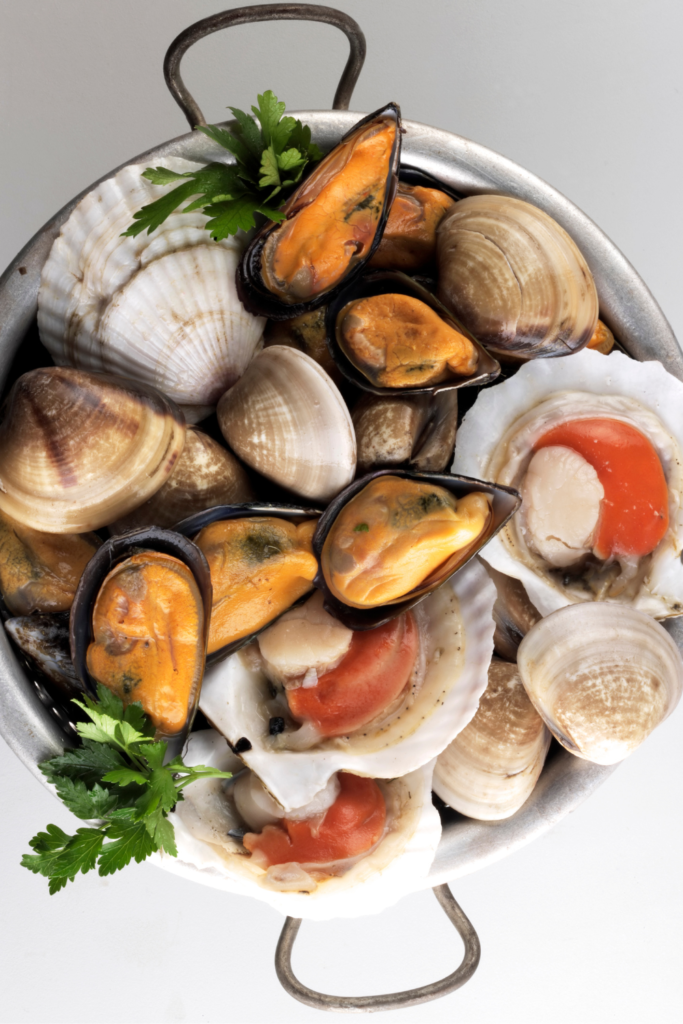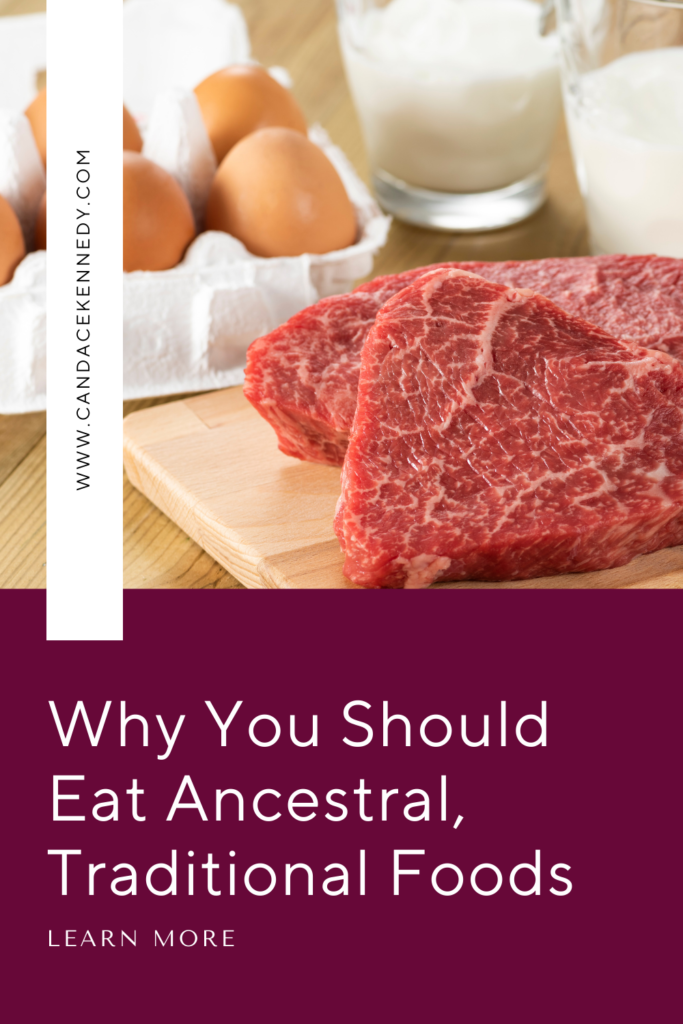The way we eat today is drastically different than the way humans ate centuries ago. And this is not a good thing. The way we eat now is not aligned to human biology. Our cells, our genes need traditional foods to thrive. Traditional foods are foods that humans have been eating for millions of years. They are foods that our bodies recognize as food.
Food is a messaging system.
Food is so much more than calories. Food is a messaging system. The food you eat sends chemical messages to every cell in your body. If the source of the message (or food) is high quality and the message arrives minimally damaged or completely intact, the better your health will be. Traditional foods are foods that humans have eaten for centuries or more. Our genes and cells recognize the messages from these foods.
Many ingredients in modern-day food are simply not compatible with normal genetic function.
Modern foods are a far cry from healthy.
In the early 1900s, at the beginning of the industrial revolution, we saw a huge shift in how food was grown, packaged, and prepared.
For example, “vegetable oils” (or more accurately described, industrial seed oils) weren’t even introduced to the American diet until the early 1900s. Prior to that, these oils, like canola, were industrial byproducts and treated as waste until food manufacturers realized they could bleach, deodorize, and drastically alter the oil and then market it as a cooking oil.
Around the same time, the American Heart Association was formed (thanks to a generous donation by Proctor and Gamble, the manufacturers of industrial seed oils and trans fats like Crisco. Yikes!). The war on traditional fats, like butter, lard and tallow began.
Since this time, our food has been increasingly modified from its natural state. Powerful marketing teams from billion-dollar food manufacturers have led the public to believe that eating a bowl of iron-fortified bran flakes cereal with a cup of soy milk, and some synthetic vitamin-fortified juice is a healthier breakfast than eggs and mushrooms cooked in butter with some fresh, in-season fruit.
While these marketing teams are persuasive, they are rarely selling true health. True health comes from eating real foods. Traditional foods.
What are traditional foods?
Traditional foods are foods that a population has eaten over a long period of time. These foods are unaltered and contain the highest levels of nutrients in their most natural state.
Before industrial seed oils were invented and the advent of highly-processed foods, humans ate REAL food. Foods were selected based on taste, seasonal availability, digestibility, and how people would feel after eating them.
This may look slightly different depending on your ethnic background and where your ancestors settled. Were your ancestors from Europe, Asia, or Africa? Did they settle along the equator or further north? Our individual gut microbiomes are a reflection of our ancestors’ diets.
For example, people of Asian descent have specific microbes to help them digest soy and seaweed easily. If your ancestors settled along the equator, their diet was likely heavier in carbohydrates and fruits, so you can likely handle more carbohydrates and fructose than someone of Northern European descent.
While traditional foods may vary from culture-to-culture, there are similarities across all populations.
- No refined or denatured foods.
- Consumption of animal foods, including organ meats.
- At least four times the minerals, and TEN times the fat-soluble vitamins as the average American diet. Fat-soluble vitamins are vitamin A (retinol), E, D, and K2 and are found in animal foods. Dr. Price referred to vitamin K2 as activator X and noted its crucial role in teeth, jaw, and facial formation (more activator x = straighter teeth and more symetrical (beautiful) faces).
- A portion of animal foods consumed raw.
- Fermented foods including lactofermented beverages, yogurts, kefirs, beet kvass, kimchi, sauerkraut, etc. Fermented foods are a great source of probiotics and are easier on digestion.
- Processes such as soaking and spouting of grains and legumes to reduce the anti-nutrient content of foods.
- A very small percentage of fat (about 4%) coming from polyunsaturated fats (found in nuts, seeds, grains, legumes). The rest of fat was from primarily saturated fats and some mono-unsaturated fats.
- A 1:1 ratio of omega 3 to omega 6 fatty acids.
- Salt, in its unaltered form.
- Use of bones in cooking, especially bone broths.
- Prioritizing nutrient-dense foods, like organ meats, for children and pregnant women, and couples trying to conceive.
Traditional Foods, according to Weston A. Price
The Weston A. Price Foundation website has a fantastic description of traditional foods, according to the research done by Weston A. Price:
“It is these real, whole, nourishing foods enjoyed for generation upon generation that provide the cells of our bodies with the necessary fats, proteins, vitamins, minerals and phytonutrients needed for vibrant health. This state of well-being is characterized by a quiet and strong digestive system, superior brain function, blissful sleep, sturdy bones, calm mind and an immune function that prevents infection.”
Price found that the native groups eating their traditional wholesome diet had less than one percent of their permanent teeth decayed. You may be thinking, ‘They must have brushed their teeth day and night!’ In fact, these cultures never used a toothbrush. The good doctor concluded that the state of one’s teeth was an excellent reflection of the state of one’s overall physical and mental health. Moreover, those consuming nutrient-dense foods produced offspring with beautifully round faces, and jaws wide enough to accommodate all their teeth with proper spacing, few or no cavities, and broad heads to allow for proper brain development. No one needed braces in societies consuming traditional foods!”
Food sends information to your cells
Food is information that helps our DNA do its job. Our chromosomes are not made of static information. Instead, our genes are constantly adapting, learning, and evolving.
Sadly, most of the food eaten on a Standard American Diet (SAD) is from low-quality sources, loaded with metabolically-disrupting PUFAs, and is so overly processed that its messages arrive damaged and give our DNA the wrong messages altogether.
Our genes will work properly unless their functions are disrupted. And some of the biggest disruptors known include highly processed food, industrial seed oils, and toxins.
Nourish your body with traditional foods that your cells and genes will recognize.
So, what can you do to help your genes express better outcomes for your health? You can change their environment. Give your body food that your body will actually recognize as food, not something made with GMOs or additives that our genes have never seen. Traditional foods are foods our genes have been exposed to for centuries or more.
Humans have been eating (grass-fed) meat since the beginning of humans! How can it be that all of a sudden, the staple of the human diet is “bad” for us and plant-based frankenfoods from a factory are supposed to be superior?
Meat is incredibly nutrient-dense and provides us with nutrients in their most bioavailable form, as well as complete essential amino acids. Your genes know exactly what to do with the chemical messages sent when you consume meat.
When meat is cooked on the bone, you also get those important compounds and amino acids from connective tissue like gelatin and glycine.
What foods are considered traditional foods:
Some examples of traditional foods that we see across cultures and over centuries:
- Grass-fed meats and game animals. Some great options for sourcing quality meat are:
- Your local farmers market
- US Wellness Meats
- Northstar Bison (I especially love their chicken and pork, as they are corn and soy free)
- Organ meats (you can easily get organ meats these days in capsule form)
- Pasture-raised eggs (look for corn and soy free eggs)
- Cooked in-season vegetables
- In-season fruit
- Collagen and gelatin-rich foods like bone broth
- Shellfish
- Raw dairy
- Fermented foods
- Sprouted foods
- Raw honey
- Wild fish
An Ancestral Diet Isn’t Restrictive, It’s Liberating
If you avoid processed foods, industrial seed oils, refined sugars, factory-farmed meat, GMOs, and basically, most foods that come from factories, is that a restrictive diet? In my experience, both in my own diet and the work I do with clients, it’s the complete opposite. An ancestral diet is incredibly satisfying and liberating.
Your genes, your brain, your cells….they all CRAVE traditional foods. When you give them the foods they were designed to consume, full of bioavailable nutrients, it LIGHTS YOU UP. Seriously.
You can’t fool your body with fake foods. Your body is smarter than that.
I spent so much of my life feeling like complete crap. I did the low-fat, low-calorie, packaged diet foods, soy plant burgers, fake milk, fake butter, fake everything. I felt miserable! My body was crying out for nutrients and nourishment and all it was getting was chemicals and GMOs.
I eat traditional foods now. Foods that our genes recognize as food: grass-fed meats, organ meats, raw dairy, pasture-raised eggs, in-season fruit, cooked vegetables, raw honey, bone broth, shellfish…DELICIOUS FOODS!
It is incredibly liberating to wake up with energy every day, free of brain fog, full of joy (or, at the very least, with a mood matching my current circumstances), balanced hormones, good digestion, AND also absolutely love all the foods that I eat. That is the opposite of restriction. Eating the foods that make you feel your best is liberating. Taking charge of your health is liberating!
Once you remove all those processed foods from your diet, you stop craving them. I don’t pass on a bag of Oreos or French fries because I’m being “restrictive.” I pass because I have absolutely no interest in eating that. Not a cell in my body craves those fake and addictive ingredients anymore. It has lost all appeal. How liberating is that?!
Your turn. How are you incorporating more traditional foods into your diet? Which foods make you feel your best and most nourished?
Important Notes
I am not a doctor, and I don’t claim to be one. I can’t prevent, treat, cure or diagnose illness or disease. The information presented on this website is not meant to replace a one-on-one relationship with a qualified health care professional and is not intended as medical advice, treatment or diagnosis. The purpose of this website is to share knowledge from my research and experience. I encourage you to make your own decisions regarding your health care based on your own research and relationship with your health care professional.
Some of the links on this page are affiliate links, which means I earn a small commission if you purchase through that link, at no additional cost to you. Thank you for supporting my work!




